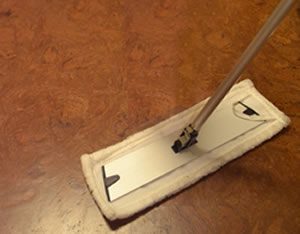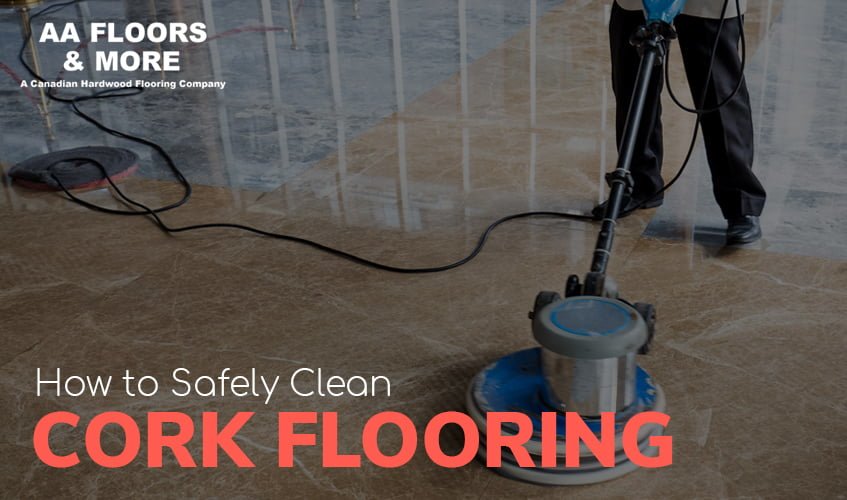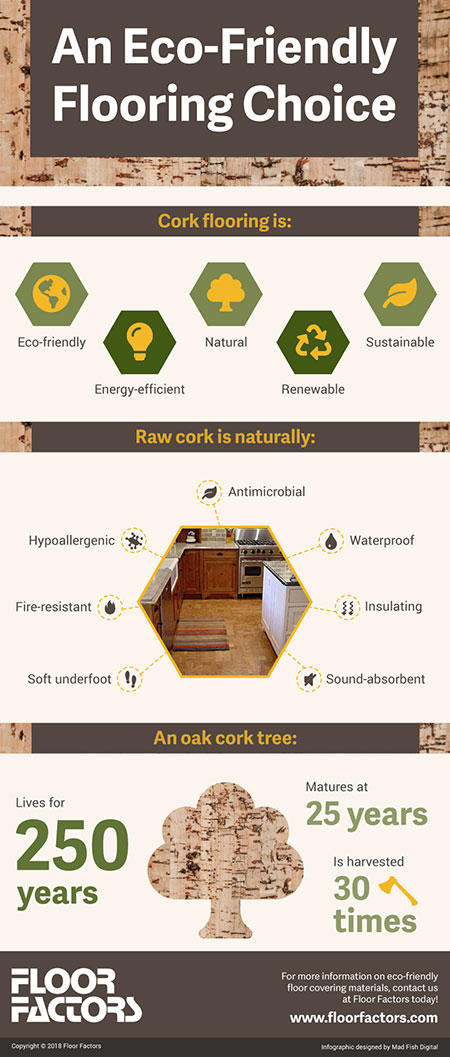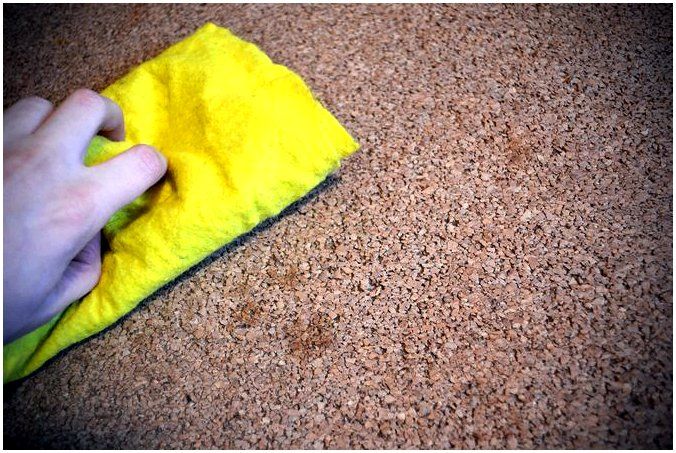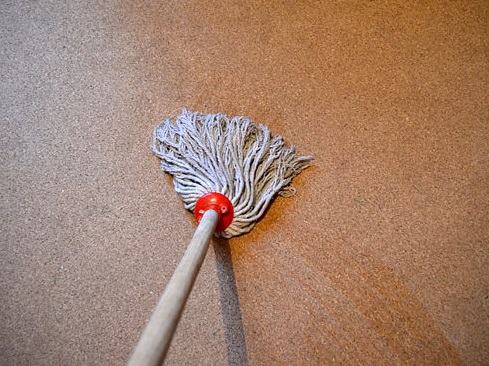The Unique Properties of Cork Flooring
Cork flooring is an eco-friendly and versatile option that has gained popularity in recent years. To fully appreciate its benefits and ensure its longevity, it’s essential to understand its unique properties.
- Natural Resilience Cork flooring is known for its natural resilience and cushioning effect. Made from the bark of the cork oak tree, it has a cellular structure that gives it a soft, bouncy feel underfoot. This makes it comfortable to walk on and reduces fatigue, especially in areas where you stand for extended periods.
- Thermal Insulation One of the standout features of cork flooring is its excellent thermal insulation properties. Cork naturally retains heat, making it a warm and cozy option for colder climates. This can also contribute to energy savings, as it helps maintain a consistent temperature within your home.
- Sound Insulation Cork’s cellular structure also provides effective sound insulation. It absorbs noise and reduces sound transmission between floors, making it a great choice for multi-level homes or apartments. This property helps create a quieter, more peaceful living environment.
- Durability and Flexibility While cork is softer than traditional hardwood, it is surprisingly durable. Its flexibility allows it to withstand heavy foot traffic and resist impacts without denting. Cork floors can also self-heal minor scratches and indentations, maintaining their appearance over time.
- Hypoallergenic Properties Cork is naturally resistant to mold, mildew, and pests, making it a hypoallergenic flooring option. Its anti-microbial properties ensure a healthier living environment by preventing the growth of common allergens. This makes cork an excellent choice for households with allergy sufferers.
- Sustainable and Eco-Friendly Cork flooring is a sustainable choice as it is harvested from the bark of cork oak trees without harming them. The trees regenerate their bark every nine years, making cork a renewable resource. Additionally, the production process generates minimal waste, and many cork flooring options are made from recycled materials.
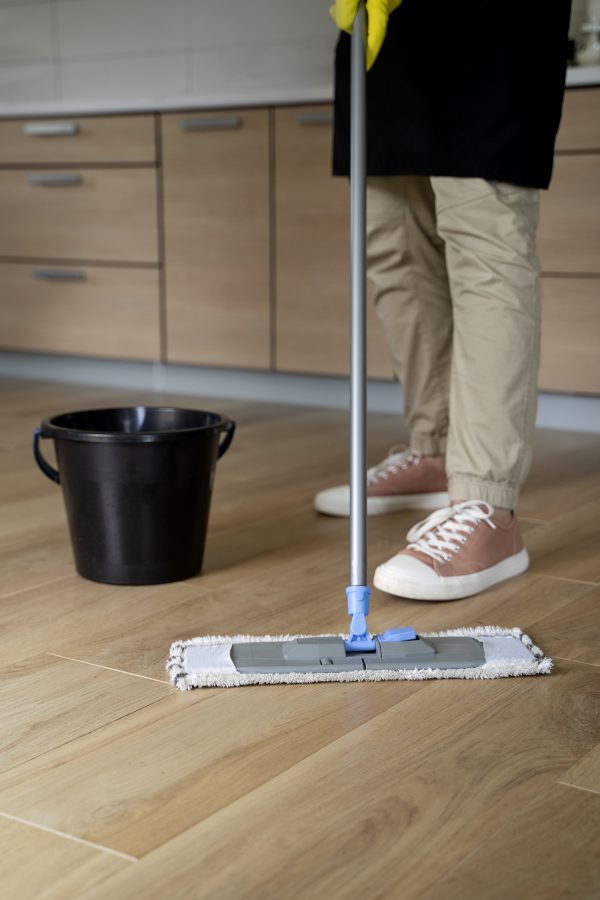
Daily Maintenance Tips
Cork flooring is not only beautiful and durable but also relatively easy to maintain. Here are some daily maintenance tips to keep your cork floors looking their best.
Regular Sweeping Daily sweeping with a soft-bristle broom or a dust mop is essential for removing dust, dirt, and debris that can scratch the surface of cork floors. This simple task prevents abrasive particles from grinding into the floor and causing damage.
Gentle Vacuuming If you prefer vacuuming, use a vacuum cleaner with a hardwood floor attachment or one designed for bare floors. Avoid vacuums with beater bars or harsh brushes, as they can scratch and damage the cork surface. Vacuuming once or twice a week can help keep your floors clean and free from dust.
Spot Cleaning For minor spills and stains, use a damp cloth or sponge to wipe up the mess immediately. Avoid using excessive water, as cork is porous and can absorb moisture, leading to potential damage. Mild soap and water can be used for tougher spots, but make sure to dry the area thoroughly afterward.
Use Doormats and Rugs Place doormats at entryways to catch dirt and moisture before they reach your cork floors. Area rugs and runners can also be used in high-traffic areas to provide additional protection. Make sure these rugs have a non-slip backing to prevent them from shifting and causing accidents.
Furniture Pads Attach felt pads or coasters to the legs of furniture to prevent scratches and dents. When moving heavy furniture, lift it instead of dragging it across the floor. These simple precautions can help maintain the integrity and appearance of your cork flooring.
Avoid Harsh Chemicals Refrain from using harsh chemicals, abrasive cleaners, or ammonia-based products on cork floors. These substances can damage the finish and the cork itself. Stick to mild, pH-neutral cleaners specifically designed for cork or hardwood floors to ensure safe and effective cleaning.
Deep Cleaning Techniques
Regular maintenance is essential, but deep cleaning your cork floors periodically ensures they remain in top condition. Here’s how to deep clean cork flooring effectively.
Preparation Start by removing all furniture and rugs from the room to give you unobstructed access to the floor. Sweep or vacuum the floor to remove loose dirt and debris. This initial step prevents dust and particles from becoming embedded in the cork during the deep cleaning process.
Choose the Right Cleaner Select a cleaner specifically designed for cork or hardwood floors. Avoid harsh chemicals and abrasive cleaners that can damage the cork. A mixture of mild dish soap and warm water is also effective. Always test the cleaner in an inconspicuous area first to ensure it doesn’t damage the floor.
Mopping Technique Use a damp mop to clean the floor, ensuring it is not overly wet. Excess water can seep into the cork and cause swelling or warping. Mop in small sections, and immediately dry each area with a clean, dry cloth or mop to prevent moisture from sitting on the surface.
Tackling Stubborn Stains For stubborn stains, use a soft-bristle brush or a sponge with a bit of the cleaner. Gently scrub the stained area in a circular motion. Avoid scrubbing too hard, as this can damage the cork. Once the stain is removed, wipe the area with a damp cloth and then dry it thoroughly.
Buffing for Extra Shine After deep cleaning, you can buff the floor to restore its natural shine. Use a soft, dry cloth or a microfiber mop to gently buff the surface. This step helps to remove any remaining residue and enhances the luster of your cork flooring.
Regular Deep Cleaning Schedule Aim to deep clean your cork floors every six months or as needed, depending on the level of foot traffic and wear. Regular deep cleaning not only keeps the floors looking their best but also extends their lifespan by preventing dirt and grime from causing long-term damage.
Dealing with Stains
Stains on cork floors can be concerning, but with the right approach, they can be effectively managed. Here’s how to tackle various types of stains on cork flooring.
Immediate Action The best way to deal with stains is to address them as soon as they occur. Promptly blot spills with a clean, absorbent cloth to prevent them from soaking into the cork. Avoid rubbing the spill, as this can spread the stain and push it deeper into the floor.
Water Stains Water stains are common on cork floors due to their porous nature. If you notice a water stain, gently blot the area with a dry cloth. For stubborn stains, mix a solution of equal parts vinegar and water, dampen a cloth with the solution, and gently rub the stain. Dry the area thoroughly with a clean cloth.
Oil and Grease Stains Oil and grease stains can be tricky to remove. Sprinkle baking soda over the stain to absorb the oil. Let it sit for a few hours or overnight, then vacuum up the baking soda. If the stain persists, use a mild dish soap mixed with water and gently scrub the area with a soft-bristle brush. Rinse with a damp cloth and dry thoroughly.
Ink and Dye Stains Ink and dye stains can be particularly challenging. Use a small amount of rubbing alcohol on a cloth to blot the stain gently. Avoid using too much alcohol, as it can damage the finish. Rinse the area with a damp cloth and dry it immediately. If the stain remains, consider consulting a professional cleaner.
Pet Stains Pet stains can cause both discoloration and odor. Blot the stain with a paper towel to absorb as much liquid as possible. Mix a solution of vinegar and water to clean the area, then use a pet-specific enzymatic cleaner to break down the odor-causing compounds. Rinse with a damp cloth and dry thoroughly.
Preventing Future Stains Preventing stains is the best approach to maintaining the beauty of your cork floors. Use area rugs in high-traffic areas and places where spills are likely to occur. Clean up spills immediately and avoid using harsh chemicals or abrasive cleaners that can damage the floor’s finish.
Protecting Your Cork Floor from Damage
Cork flooring is durable, but it still requires protection to maintain its beauty and integrity. Here are effective ways to protect your cork floors from damage.
Use Furniture Pads Furniture legs can cause scratches and dents on cork floors. Attach felt pads or rubber coasters to the bottom of all furniture to prevent damage. Replace these pads regularly to ensure they remain effective.
Avoid Sharp Objects Sharp objects can easily puncture or scratch cork flooring. Be mindful when handling knives, scissors, or other sharp tools. If you need to move heavy furniture or appliances, lift them instead of dragging them across the floor to avoid scratches.
Limit Direct Sunlight Prolonged exposure to direct sunlight can cause cork flooring to fade or discolor. Use curtains, blinds, or UV-resistant window film to protect your floors from harmful UV rays. Rearranging rugs and furniture periodically can also prevent uneven fading.
Maintain a Stable Environment Cork flooring can expand and contract with changes in temperature and humidity. Maintain a consistent indoor environment to prevent warping or gaps between the tiles. Use a humidifier in dry climates and a dehumidifier in humid conditions to keep the humidity levels stable.
Regular Sealing Applying a sealer to your cork floors provides an additional layer of protection against moisture, stains, and wear. Follow the manufacturer’s recommendations for sealing frequency, typically every few years. A properly sealed cork floor is more resistant to damage and easier to clean.
Mind Your Footwear Wearing high heels or shoes with cleats can damage cork flooring. Encourage family members and guests to remove their shoes before walking on the floor. Consider providing slippers or indoor-only shoes to minimize the risk of damage.
Eco-Friendly Cleaning Solutions
Cork flooring is a sustainable choice, so it makes sense to use eco-friendly cleaning solutions to maintain it. Here are some green cleaning options for cork floors.
Vinegar and Water Solution A mixture of vinegar and water is a simple, effective, and eco-friendly cleaning solution for cork floors. Mix one part white vinegar with four parts water in a spray bottle. Spray the solution onto the floor and wipe with a damp mop. Vinegar is a natural disinfectant that cleans without leaving harmful residues.
Baking Soda Paste Baking soda is an excellent natural cleaner for tackling tough stains. Mix baking soda with a small amount of water to create a paste. Apply the paste to the stain and gently scrub with a soft-bristle brush. Rinse with a damp cloth and dry the area thoroughly. Baking soda is non-toxic and safe for both the floor and the environment.
Castile Soap Castile soap is a biodegradable, plant-based soap that can be used for various cleaning purposes, including cork floors. Dilute a few drops of castile soap in a bucket of warm water and use a damp mop to clean the floor. This gentle soap cleans effectively without leaving harmful chemicals behind.
Essential Oils Essential oils like tea tree oil, lavender oil, and lemon oil have natural antibacterial properties and can be added to your cleaning solutions for a pleasant fragrance and additional cleaning power. Add a few drops of your preferred essential oil to your vinegar and water solution or castile soap mixture for enhanced cleaning and a fresh scent.
Microfiber Cleaning Cloths Microfiber cloths are an eco-friendly cleaning tool that requires only water to clean effectively. These cloths attract and hold dirt, dust, and allergens without the need for chemical cleaners. Use a damp microfiber cloth or mop to clean your cork floors regularly. They are reusable and can be washed multiple times, reducing waste.
Commercial Eco-Friendly Cleaners There are many commercial cleaning products available that are specifically designed to be environmentally friendly. Look for cleaners that are labeled as biodegradable, non-toxic, and safe for use on cork floors. These products are formulated to be effective while minimizing their environmental impact. Always read the labels and follow the manufacturer’s instructions for the best results.
How to clean cork floors in the best way?
How to Clean Cork Flooring » How To Clean Stuff.net
Long-Term Cork Flooring Maintenance and Care Instructions
Related Posts:
- Black Cork Flooring
- Cork Flooring For Basement
- Cork Floor Design
- Cork Flooring In Bedroom
- Light Colored Cork Flooring
- Using Cork Flooring In A Kitchen
- Staining Cork Flooring
- Dark Cork Flooring
- Mid Century Cork Flooring
- Cork Flooring Options

